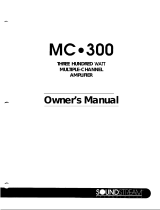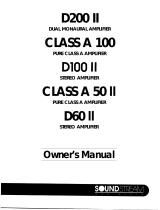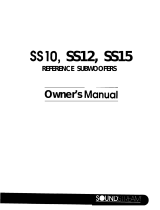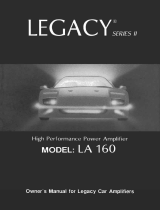Page is loading ...

MC 500
Five Hundred Watt
Multiple-Channel
Amplifier
P

.
Thank you for purchasing a Soundstream amplifier. You now own the finest high
power amplifier available, a precision component capable of audiophile-quality
performance.
CONTENTS
Wiring diagram
3
Design feature
4
Installation
5
Power connections
6
Remote power-on connection
7
LED power indicators
a
Selecting operating mode
a
Input connections
9
Output connections
10
Optimizing for speaker impedance
11
Input level adjustment
11
Linear Subwoofer Extension
12
Protection circuits
13
Service
13
Specifcations
14

-
3
-
Figure
I 2Channel
Opmztian
Flgun 2
3.Channel
OperatIm
I
,-,

-4-
7-.
DESI6U
FEATURES
The Soundstream MC500 is the ultimate amplifier for high-power automotive
applications.
The MC500 is conservatively rated at 500 watts into 4 ohms. This power can
be divided into four channels (4 x 125 watts.), three channels (2 x125 watts,
1
x
250 watts), or stereo (2 x 250 watts).
Each output device is individually
rated at 125 watts, and there are 24 discrete output devices in the MC500, for
a total of 3 kilowatts of device capability.
With such reserves and no current
limiting, the MC500 operates without strain even at maximum output. Power,
ground, and speaker connectors are rated to handle up to 80 amps and up to
6 gauge wire.
The MC 500 incorporates a unique protection system that prevents thermal
overload without the need for a fan. Should the unit approach an overheated
condition, dynamic headroom is reduced instead of a complete shutdown,
until normal operating temperature is reached. Then full output capacity is
restored.
The entire process is automatic and inaudible. In the case of a
malfunction which should cause continued overheating, secondary thermosats
will shut down the amplifier in a conventional manner.
An especially useful feature of the MC500 is the Linear Subwoofer Extension
Circuit
(LSE),
which
c.ompensates
for the natural
rolloff
of most speakers and
extends bass as much as a full octave.
LSE provides a
~linear
boost of 6
dB/octave.
starting at a point which is continuously variable over the range 35-280 Hz.
A steep 24
dB/octave
filter attenuates the signal below 20 Hz.
Only premium parts are used in the MC500, such as metal-film resistors,
go!d-
plated input connectors, and
imnersible
sealed potentiometers. The case is
equipped with generous heat sinks.
Input sensitivity is adjustable to match
any tuner/deck--the MC500 can even be used as a power booster.

-5-
-.
The MC500 features dual-monaural construction, with two fully independent soft
regulated pulse-width modulated power supplies that provide stability for
low-
impedance reactive loads (down to 2 ohms/4 channel operation) and still allow
greater than 2
dB
IHF dynamic headroom.
All gain devices are biased by regu-
lated active current sources, so that even low-frequency performance is
unaffected by supply-line noise and temperature fluctuations.
INSTALLATION
Proper
installation and adjustment will reward you with reliable operation and
optimum performance.
Automotive sound system installations can be tricky,
especially for first timers.
For this reason, you may want to consider using
a professional installer who has the tools and, more importantly. the experience,
to do the job right.
If
you decide to install your equipment yourself, we hope
that this manual will serve as a helpful guide.
Location and mounting
The first step in installation is thorough planning. Choose the location for
your amplifiercarefully. The amplifier should be located in either the passen-
ger compartment or the trunk, never in the engine compartment or in any outside
location exposed to dirt and moisture.
Adequate ventilation is important; allow
enough space so that air can circulate around the heat sinks.
Make sure that the installed amplifier will not interfere with normal operation
of the car.
It is best not to locate the amplifier near your antenna. because
the switching power supply can interfere with AM reception.

Your amplifier should be mounted firmly to your car's sheet metal with the four
screws provided.
Use your amplifier as a template for making pencil-marks
where you intend to drill.
(Do
not operate your drill through these mounting
holes.)
It's a good idea to bench test your system before mounting the components.
If
you have a 12-volt power source, you can connect and test all the
commponents
outside the car.
Or you can connect then inside the car before screwing them
down.
Either way, connect the components exactly as you intend to in the final
installation: make all power connections last; test the system; then discon-
nect all power until the final installation is complete.
Wiring
Determine how your car's wiring is laid out, and run your wires in the same
locations when possible.
Many passageways,wire-hooks, and strain relief devices
already exist in your car; take advantage of them. Keep all wiring inside the
car.
Good standard audio practice suggests keeping signal wires short and
away from power lines.
Wires can be run under carpet. If you drill a new
passage-hole through metal, make sure no burrs remain to scrape the wire; use
grommets as needed. All wires should be hidden; an exposed wire can inadver-
tently be pulled, causing disconnection or shorting. Wires should never be
under tension or subject to moisture. Use cable ties to bundle excess wire.
POWER CONNECTIONS
NOTE: Your amplifier can only be operated from a 12-VOLT NEGATIVE GROUND
electrical system.
If your car was produced before 1970, or if you have any
doubts, make sure of the type of electrical system you have before making any
connections.

The MC500 will draw up to 70 amperes if used to its fullest capability. Deter-
mine the alternator rating of your car and the current consumption of the car's
other accessories.
It may be necessary to upgrade the alternator or to install
a separate battery, especially
in
cold climates.
For power wiring, use 8-gauge wire or larger.
(Smaller gauge numbers denote
larger wire.) The (PLUS
12V>
terminal
((3,
in the wiring diagram) should be
connected directly to the positive
(+)
terminal of your car battery.
Install
two
(2)
30 amp fuses (in parallel) in the line close to the battery terminal.
If you have more than one amplifier, each amplifier should be separately fused.
The
(GROUND,
terminal
(2)
should be connected directly to the automobile chassis
with 8-gauge wire or larger. Make this wire as short as possible to prevent
noise in the system.
A nearby bolt can serve as a ground terminal. Make sure
that the wire contacts bare metal, not coated metal or paint.
It is important
that the ground connection you select
hav_
e
minimal noise resistance to the
battery ground post (a maximum of 0.1 ohm).
REEIOTE
POWER-ON CONNECTION
If your tuner/deck has a remote power-on control wire or terminal, connect it
to the <REMOTE> terminal
(1)
on your amplifier. This is a control line, not a
power line, so small wire (18-20 gauge) is acceptable.
If your tuner/deck has no remote power-on control labeled as such, but has a
power antenna control,
it may be possible to wire the power antenna control to
the (REMOTE) terminal.
..-

-a-
If your tuner/deck has neither a remote power-on control wire nor a usable
power antenna control, it will be necessary either to connect the <REMOTE>
terminal
tu
a
+I2
volt source which is switched by the ignition key, or to con-
nect the (REMOTE> terminal to a constant t12 volt source through an on-off switch
you install in series with the ignition switch in a location accessible to
the driver.
LED
PDUER
INDICATORS
The two main channels of the MC500 (A and
B)
are completely independent, and
each has its own LED indicating power-on:
(13)
for main CHANNEL A, and
(24)
for
main CHANNEL
8.
Since power should be disconnected during installation, these
LEDs
should be dark until you are finished! Both
LEDs
will go out if the
power-line fuses are blown; if a chassis fuse is blown, only the LED for that
_
amplifier section will go out.
SELECTIND
OPERATING
mDE
The five hundred watts available from the MC500 can be divided into two
channels (stereo) [Figure 11, three channels (stereo plus a single-channel
subwoofer) [Figure
21,
or four channels (front and rear stereo; or stereo
bi-amp) [Figure
31.
To select any of these modes, remove the plug covers marked CHANNEL A and
CHANNEL B on the bottom of the amplifier switch.

-9.
h
For two-channel operation, set both switches to <MONO>.
For three-channel operation, set one switch to <STEREO>
and the other to (MONO). Note carefully which
is which, because you must connect wires
accordingly.
For four-channel operation, set both switches to <STEREO>.
INPUT CONNECTIONS
Inputs to the amplifier attach by means of standard RCA-type jacks. The MC500
achieves a level of performance at which cable and connector quality is sig-
nificant; the jacks on your amplifier are gold plated, and we recommend premium
gold-plated plugs and high-quality shielded cable.
P
In most cases, the signal source will be the preamp output jacks of a tuner/deck.
Some tuner/decks use preamp output connectors other than RCA jacks, in which
case you will need a special cable or adaptor available from your dealer.
If your tuner/deck has speaker outputs and no preamp outputs, you can use the
speaker outputs.
Wire RCA-type plugs to the ends of your tuner/deck's output
wires, making sure that you maintain consistent polarity in all channels.
If you have an equalizer or low-level crossover network(s) for bi-or
tri-
amping,
these components will be inserted between your tuner/deck and your
amplifier(s).
Refer to the manuals for these components for further details.
In 4-channel mode, all four input jacks
<15),
(16>,
<26>,
and
(27)
are active
for CHANNEL A left and right and CHANNEL B left and right, respectively.
In Z-channel mode, use oniy the "right" jack
(16>
for CHANNEL A, and only the
"right" jack
(27)
for CHANNEL
E.

In 3-channel mode, use only
rthe
"right jack for whichever of main CHANNEL A
or CHANNEL
B
is operating in mono,
and both jacks for the other main channel.
OUTPUT CONNECTIONS
Use high-quality loudspeaker cable for best results; use 14-gauge cable as
a minimum size.
In 4-channel mode, all four terminals
<6),
(7>,
<El),
and
(9)
are active for
main CHANNEL A, and all four terminals
t17),
(18>,
<19>,
and
(20)
are active
for main CHANNEL 8.
In
2-channel
mode, use only the
"+"
terminals
(17)
and
(20)
for CHANNEL
6.
The
'+
right" terminals
(9)
and
(20)
have positive polarity in this mode.
In 3-channel mode, use only the
I'+"
terminals for whichever of main CHANNEL A
or CHANNEL B is operating in mono, and all four terminals for the other main
channel.
The terminals on your loudspeakers are marked for polarity, and loudspeaker wire
is coded by color or by markings on the jacket. Be sure to connect the left
and right channels with the same polarity.
Loudspeaker manufacturers are not
consistent in their polarity markings, so if you have loudspeakers of different
types connected to the same amplifier terminal,
verify correct polarity by ear.
The correct polarity produces the most bass; incorrect polarity produces
less bass and a strangely dislocated sound image on mono material.
If you have more than one amplifier: for each amplifier and its loudspeakers.
the left and right channels must always be wired with the same polarity. But
from one amplifier to the next, correct polarity may be the same, or it may be

-
11
-
C
reversed.
This is because of differences in amplifier design, the nature of
crossover filters, and other factors.
Again, experiment and verify the
correct polarity by ear.
OPTIMIZING FOR SPEAKER
INPEDANCE
As delivered from the factory, your MC500 has been optimized for 4 ohm operation.
It is' possible to optimize this amplifier to deliver maximum performance into
2-7
4-, or B-ohm loudspeakers. This is done by means of plug-in fuses behind
a door on the bottom of the amplifier.
Remove the screw in the door and pop the door open, and you will see four
receptacles: two for CHANNEL A and two for CHANNEL
6.
Two fuses will already
be installed in one of the receptacles for
each
channel, To optimize the MC500
impedance, move the appropriate
pair
of fuses for
each channel.
Note that the
fuse (pair) positions will optimize main CHANNEL A or CHANNEL B for 4 or 2
ohms
in 4-channel mode (or for the 2-channel half in 3-channel mode); or for
8
or 4 ohms
in bridged (mono) mode. If you are unsure of the impedance of your speakers, or
are wiring more than
_
one speaker to a set of terminals, consult
your dealer or installer for the best settings.
INPUT LEVEL ADJUSTMNT
Input levels are adjusted by means of four independent controls that are acces-
sible through the heat sink directly above the input connectors.
The controls
can be turned with a small, flat-head screwdriver.
In 4-channel mode, the left and right halves of CHANNEL A are ste by controls
(12)
and
<14>,
respectively: the left and right halves of CHANNEL B are set
by controls
(23)
and
(25).

-
12
-
?
In 2-channel mode, only the "right" control
<14>
is operative for CHANNEL A,
and only
(251
for CHANNEL B.
In
3-channel mode, use only the "right" control for whichever of main CHANNEL A
or CHANNEL B is operating in mono,
and both controls for the other main channel.
Depending on lhow you are using your MC500 (number of channels, biamplification.
associated equipment, etc.), different factors may apply for optimum gain set-
tings.
In general, begin by turning all level controls to minimum (full counter-
clockwise).
Turn the system on, and set the volume control on your tune/deck
at its mid-point.
Advance the amplifier input level controls until you have
reached a comfortable listening level and both
cahnnels
are in balance.
NOTE:
with many tuner/decks, the radio output level is significantly different than
the tape output level. Check both sources, and set levels using the lesser of
the outputs (usually the tape).
LINEAR
SUUUOUFER
EXTENSIUN
CIRCUIT
(LSE)
The LSE circuit will compensate for the natural
rolloff
of most loudspeakers.
and can extend dep bass by as much as a full octave. For CHANNEL A, LSE is
engaged by pressing switch
(ll>,
and the frequency is adjusted by control
(10).
For CHANNEL B, LSE is engaged by pressing switch
(22),
and the frequency is
adjusted by control
<21>.
If either CHANNEL A or CHANNEL B is operating in
stereo, LSE will be applied to both left and right.
The control allows for continuously variable adjustment, over the range from
35 Hz to 280 Hz, of the frequency at which LSE begins its boost. Below the
chosen frequency, the boost is applied at 6
dB
per octave.
When properly
adjuste?.
LSE will "linearize" the low end of the woofer(s) and provide remarkably smooth
and deep bass. A word of caution: small or inexpensively constructed woofers may
be unable to handle the equalization which results from setting the LSE to
abotje
-
100 Hz.

-
13
-
PROTECTION CIRCUITS
Your amplifier is protected against both overheating and short circuits.
Because of the "soft" thermal protection (see the Design Features section
above),
it-is
highly unlikely that the amplifier will shut off because of
thermal overload.
If your amplifier shuts down, turn off the system,
*ait
for a few minutes, and
turn the system on again.
If the amplifier does not come on again:
Check the loudspeaker wires for shorts using an ohmmeter
or continuity checker.
Check
the LED indicators.
If both are out, check the
relay or fuse in the power line; if that fuse is blown,
replace it with another fuse of identical type and value
and try again.
If one of the
LEDs
is out, or if both are out and the
power line fuse is not blown, check the chassis
fuse(s)
(4>
and
(5).
If blown, replace with the identical type
(30-ampere).
If a fuse blows again, call your dealer or
Soundstream for service.
SERVICE
Your Soundstream amplifier is protected by a limited warranty. Please read
the warranty enclosed with the product.

-
14
-
h
Should any problem occur, contact your dealer, or you may contact Souodstream
directly.
DO
IWT
send your amplifier to Soundstream without first obtaining
a return authorization number. This will facilitate repairs and will allow
us to return your unit in the shortest possible time.
SPECIFICATIONS
Power Output
Z-channel
3-channel
4-channel
Total harmonic distortion
Signal to noise
Damping factor
IHF dynamic headroom
Maximum current draw
Idle current draw
Input sensitivity
Input impedance
Linear subwoofer extension
Dimensions
250 watts continuous per channel x 2
into 4 or 8 ohms, 20 Hz
-
20
kHz
250 watts continuous mono into 4 or 8 ohms,
20 Hz
-
20
kHz;
and 125 watts continuous
per channel x 2 into 2 or 4 ohms,
20 Hz
-
20
kHz
125 watts continuous per channel x 4
into 2 or 4 ohms, 20 Hz
-
20
kHz
1
(
0.1X,
20 Hz
-
20
kHz,
at full rated
i._
power into 2, 4, or 8 ohms
)
100
dB
)
200
>
2
d0
75 amps
<
5 amps
2%
mV
-
2.5 V, continuously variable
10k
ohms
6 dB/octave increase, variable hinge
point 35
-
280 Hz
19-t/5"
x
io-i/311
x
3-5/a”
SOUNDSTREAM
TECHNOLOGIES
2907
West 182nd
Street
Redondo
Beach Colifomio
90278
(213)
214-4652
/










